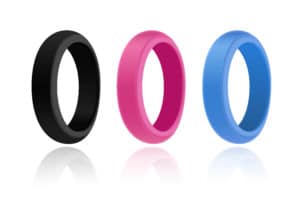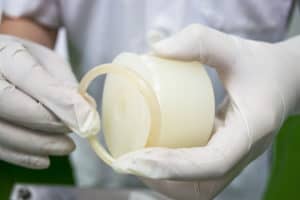
Silicone Properties
Silicone has an extensive range of uses due to its ability to withstand temperature extremes from -58° F to +450° F. Even in very low temperatures where many materials become brittle, silicone remains flexible. Silicone O-rings are extremely clean and do not retain or relay odors or taste, making them highly sought after for food, medical, and semiconductor applications. Some of the other useful properties of silicone include:
- Resistant to fungal growth
- Stands up well to hot air, UV, and ozone exposure
- Withstands weathering
- Resists damage from engine, transmission, animal, and vegetable oils and fats
- Compounding can impart qualities of electrical resistance, conductivity, or flame retardancy
- Possesses a hardness range of 30 to 80 durometer Shore A, with a standard hardness of 70 durometer Shore A
- Can be compounded to meet FDA, USDA, MIL-STD-413C, MIL-STD-105E, and MIL-I-45208A specifications
Silicone O-Ring Compatibility
As with all materials, silicone O-rings have characteristics that are more ideal for some uses and conditions than others. They are best categorized as follows:
- Recommended Applications: Silicone O-rings are recommended for applications requiring good electrical properties and resistance to heat, cold, ozone, set, weather, acid, chemicals, oil, water steam, and flame.
- Less Suitable Applications: Silicone O-rings are not recommended for applications that require high levels of tensile strength, impermeability, and significant abrasion, tear, or dynamic resistance.
Silicone O-Ring Applications

- Automotive. Used to seal fluids, lubricants, and coolant in fuel and brake systems, engines and transmission components, and automotive air conditioning systems
- Aviation and defense. Used for sealing applications in aircraft, helicopters, gun systems, and ships
- Construction and agriculture. Used in heavy-duty equipment and hardware
- Electronics. Used to seal away from dust and other contaminants that could damage delicate electronic components
- Food and beverage. Prevents cross-contamination in food and beverage processing equipment and utensils
- Medical devices. Used in pumps, syringes, filtration devices, and connectors
- Pharmaceutical. Used in drug production applications and miniature components for laboratory and analytical equipment
- Semiconductor. Used in fabricating process equipment and integrated circuits
- Utilities and HVAC. Used for sealing in heating, cooling, sprinkler, drinking water, and compressed air systems
Qualified Sealing Experts
When it comes to choosing the right O-ring for your application, material selection is critical. Arizona Sealing Devices has over 30 years of experience in supplying O-rings and other sealing solutions such as caps, plugs, gaskets, and kits in a wide variety of materials. Our talented and highly experienced team extensively researches each product so they can recommend the ideal solution and answer any questions you have about our materials and products.
We are committed to meeting or exceeding customer expectations in quality, selection, functionality, and customer service. For more information on our inventory, please see our product catalog, or contact us today with any questions.

